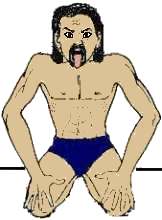| |
 |
apid |
Just what you need to know! |
| eview |
|

Basic Facts about the Yoga Posture (Asana)
The Roaring Lion Posture (whose original Indian name is Simhasana) in Yoga is suitable for people of all ages and types (including old and weak) because it is relatively easy to perform. The posture is sometimes referred to as Bhairavasana.
Note that Simha means Lion, whereas Bhairava refers to one of the formidable forms of Lord Shiva. The posture gets its name because the face of the person performing it resembles the face of a Roaring Lion (Simha Mudra or Lion Face Gesture) because of the open mouth and extended tongue.
Stepwise Technique 
- Kneel down on the ground and place your body weight on your knees, calves and heels with the toes pointing back. Keep your head and spine erect with the knees about 6-12 inches apart.
- Press your palms on the respective knees with the fingers extended straight. This is the Thunderbolt Posture (Vajrasana).
- Open your mouth fully. Exhale through your nose and mouth, and simultaneously extend your tongue comfortably out of your mouth curving it toward the chin. Hold your breath with the abdomen pulled in. Widen your eyes, bare your teeth and stretch your facial muscles so that your face looks terrifying.
- Remain in this final posture for about 10 seconds or your breakpoint*.
Tips and Comments
- The Lion Face Gesture (Simha Mudra) can alternatively be performed with other Yogic sitting postures such as the Lotus Posture (Padmasana). It may even be performed in a standing posture with the palms on the waist and the feet about 6-12 inches apart.
- Rather than look straight, an alternative is to press the chin against the chest. Focus the gaze upward at the center of the eyebrows (Bhrumadhya Drishti) or downward at the nose tip (Nasagra Drishti).
- In the early stages, you may perform this yoga posture twice daily. After regular practice, you may perform it about five times daily.
- *Breakpoint is the time upto which you can comfortably remain in a yoga posture. It varies from individual to individual depending on one's fitness, age and will power.
Potential Benefits of the Yoga Posture (Asana)
- The Roaring Lion Posture (Simhasana or Bhairavasana) provides exercise to the facial muscles. It therefore maintains the firmness and luster of the facial skin. The posture is also good for the eyes in reducing strain.
- The yoga posture helps in voice-related difficulties (e.g., stammering) and throat-related problems (e.g., hoarseness and tonsillitis) because of the stretching of the tongue.
- The yoga posture aids in better functioning of the carotid sinus, the sinus nerves, the larynx, the respiratory system as well as the thyroid and parathyroid glands. The carotid bodies assist in maintaining normal blood pressure and heartbeats, whereas the breathing exercise helps the chest and abdomen.
Disclaimer : Syvum makes no representations or warranties of any kind, express or implied, as to the correctness of the content as well as the accuracy and use of the information regarding the practice of Yoga. It is strongly advised that you consult your physician before engaging in any physical activities. The information herein is not intended to substitute professional medical opinion or qualified Yoga instructors' opinion. To the full extent permissible by applicable law, Syvum disclaims all warranties, express or implied, including but not limited to, implied warranties and fitness for a particular purpose. Syvum will not be liable for any damages of any kind arising from the use of the information regarding the practice of Yoga, including but not limited to direct, indirect, incidental, punitive and consequential damages.
|
|

